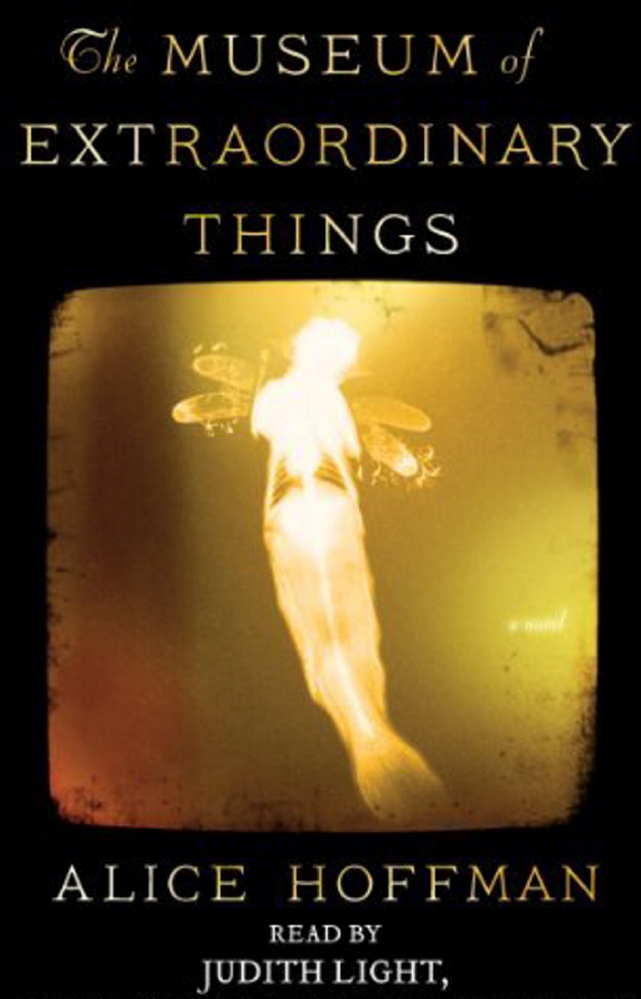Alice Hoffman’s storytelling magic is on abundant display in her new novel, which folds a romance and a tightly plotted mystery within a brilliant portrait of the splendors and miseries of New York during a pivotal year in the city’s history. It’s a pleasure to report this return to top form by Hoffman, a gifted but uneven writer whose penchant for excess marred such recent works as “The Third Angel” and “The Story Sisters.”
“The Museum of Extraordinary Things” is more disciplined, yet it exudes the same appreciation for the fantastical and the marvelous that echoes throughout Hoffman’s work.
Here, those qualities are embodied in the exhibitions at the eponymous museum, a small establishment on Coney Island run by the shady Professor Sardie. His “wonders” include a wolfman, Siamese twins and his own daughter. Coralie’s webbed fingers are dipped in blue dye, she’s clothed in a fake tail and displayed in a tank as “The Human Mermaid.” But by 1911, the museum’s attractions have been eclipsed by the gaudy amusements of Dreamland and Luna Park. We find Coralie swimming in the Hudson, unhappily complying with her father’s plan to foster rumors about a mysterious monster in the river. He will then fabricate his own monster and exhibit it to revive the Museum of Extraordinary Things.
Emerging from the Hudson in the woods of upper Manhattan, Coralie spies a young man cooking himself dinner over a bonfire. Like her, Eddie Cohen was a motherless child chafing under his father’s expectations. Unlike Coralie, Eddie walked away, abandoning life as an exploited garment worker to become a photographer of crime scenes and disasters. His experiences have fostered a grim view of human nature. While Coralie gently regards even the most disfigured of her father’s employees as “unique and fascinating,” Eddie’s judgments are harsh. He despises equally the callousness of New York’s elite and the meekness of workers like his father; he’s mortified that his rage has found no more productive outlet than taking an expensive watch from the cringing son of a factory owner at age 11.
Coralie falls in love with Eddie that very night, but she flees before he sees her in the underbrush; they won’t actually meet until the novel is two-thirds over. Hoffman expertly weaves the future lovers’ monologues with a third-person account moving through the spring of 1911 to create a wonderfully rich narrative tapestry. Her prose is as lyrically beautiful as ever, evoking the teeming complexity of New York from the green spaces soon to be consumed by commercial development to the mean streets of the Lower East Side and the pleasure palaces of Coney Island. The full-bodied supporting characters play vital roles in enunciating the novel’s themes and guiding the protagonists toward maturity – most particularly the Sardies’ housekeeper, Maureen, who nurtures Coralie until she is ready to escape from her father’s control.
The novel is bookended by two catastrophic fires: the Triangle Factory blaze of March 25, which killed 147 workers trapped on the ninth floor by locked stairwell doors; and the Dreamland conflagration of May 27, which consumed much of Coney Island. Triangle launches the mystery that ultimately brings Eddie to the Museum of Extraordinary Things, an immediate rapport with Coralie and a confrontation with Professor Sardie. Dreamland provides the novel’s apocalyptic finale, with Coralie locked in her father’s sinister basement workshop as flames sweep the amusement park and wild animals run down Surf Avenue.
The action-packed story line sweeps through labor strife, a missing Triangle worker eventually fished from the Hudson, the exposure of her murderer and a bravura plot twist that reveals the truth about Coralie’s mother. The deeper action involves Coralie and Eddie’s internal journeys. She has always thought of herself (somewhat paradoxically) as both a monster and a fake; she gains the self-acceptance to remove the gloves on her webbed hands, vowing “never to hide who I was.” Eddie learns that his furious rejection of his father has not freed him.: “The past was what we carried with us, threaded to the future. … Fate was both what we were given and what we made for ourselves.”
A tranquil letter from an upstate village pays tribute to the power that fueled their journeys, the painful but vital human connection affirmed in even Hoffman’s darkest novels. “You are the one who taught me that love was never what we expected it to be and that it was all we needed,” Coralie writes to Maureen. “For that, and for a thousand other things, I send my gratitude.”
Copy the Story LinkSend questions/comments to the editors.



Success. Please wait for the page to reload. If the page does not reload within 5 seconds, please refresh the page.
Enter your email and password to access comments.
Hi, to comment on stories you must . This profile is in addition to your subscription and website login.
Already have a commenting profile? .
Invalid username/password.
Please check your email to confirm and complete your registration.
Only subscribers are eligible to post comments. Please subscribe or login first for digital access. Here’s why.
Use the form below to reset your password. When you've submitted your account email, we will send an email with a reset code.